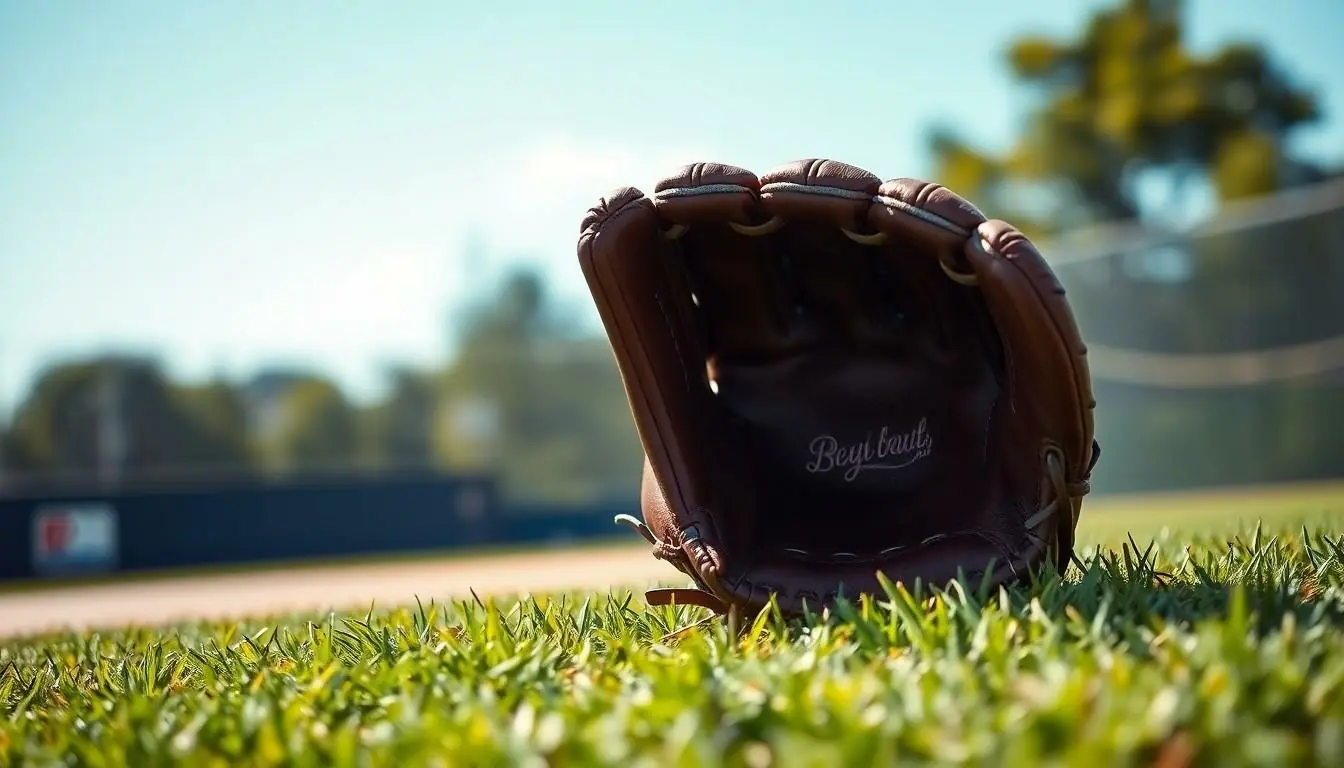For every left-handed player, finding the perfect baseball glove can feel like searching for a unicorn in a haystack. While right-handed gloves seem to have their own fan club, lefty gloves often play hard to get. But fear not, because the right lefty glove can elevate a game from amateur to all-star in no time.
Table of Contents
ToggleOverview of Lefty Baseball Gloves
Left-handed baseball gloves cater specifically to southpaw players, offering essential support for catching and fielding. Many left-handed players struggle to find gloves that fit comfortably, as most manufacturers primarily produce right-handed models. Designs for lefty gloves feature reversed orientations, allowing players to catch with their dominant hand while throwing with their right.
Materials play a crucial role in glove quality. Leather gloves, often favored for their durability, mold well to a player’s hand, improving comfort and grip over time. Synthetic options provide lightweight alternatives, appealing to budget-conscious players or those new to the sport.
Size matters when choosing a glove. Standard sizes for youth and adult players range from 10 to 14 inches, impacting player performance and comfort. Proper fit enhances catching ability, ensuring gloves don’t hinder movement or create distractions on the field.
Brands offer various lefty glove options, including Rawlings, Wilson, and Mizuno. Each brand presents unique features. Some gloves include extra padding for protection, while others prioritize flexibility for quicker plays. Customization options exist, enabling players to add personal touches, such as initials or specific colors.
Price range affects accessibility. Entry-level gloves typically start around $30, while high-end models can exceed $300. Players should assess their needs and budget to find the right glove that enhances performance on the field.
Benefits of Using a Lefty Baseball Glove

Left-handed baseball gloves offer numerous advantages for players. They provide tailored designs that greatly enhance a southpaw’s game.
Enhanced Comfort and Fit
Selecting a lefty glove ensures a natural fit tailored for left-handed players. Custom designs eliminate the discomfort associated with right-handed gloves, allowing better feel during plays. Material choices also play a vital role; leather offers a soft, snug fit that molds to the hand over time, improving comfort. Synthetic models, on the other hand, provide lightweight options for players seeking flexibility. A well-fitted glove allows quick movement, reducing fatigue during long games. Overall, the right size glove enhances the player’s confidence at every position on the field.
Improved Performance
Performance improves significantly with a left-handed glove designed for comfort and usability. The glove’s structure supports quick catching and throwing motions unique to left-handed players. Increased speed and accuracy come as players become more adept at fielding and making plays. Optimal design features, such as extra padding, absorb impact and protect the hand effectively. Various brands like Rawlings and Wilson offer models that elevate performance through innovative features tailored to left-handed players. Improved grip also boosts control of the ball, resulting in better gameplay and overall effectiveness on the diamond.
Key Features to Consider
Selecting a lefty baseball glove requires careful attention to various factors that enhance performance and comfort on the field. Understanding these key features makes the selection process smoother for left-handed players.
Material and Construction
Durability and comfort rank high among material considerations. Leather gloves stand out for their longevity and ability to mold to a player’s hand, ensuring a customized fit over time. Synthetic options appeal due to their lightweight nature and often lower price. Reinforced stitching enhances the glove’s durability, particularly in high-stress areas, contributing to long-lasting use. Additionally, some gloves feature moisture-wicking materials that help keep hands dry during play, ensuring better grip and performance.
Size and Fit Options
Size directly influences a player’s performance and comfort. Standard glove sizes typically range from 10 to 14 inches, with choices tailored to various player positions. An optimal fit allows for better ball control and quicker reflexes during games. Players must consider their hand size and desired level of comfort when choosing a glove. Many brands offer adjustable features, such as customizable wrist straps, accommodating individual preferences and ensuring a snug fit for every left-handed player.
Top Lefty Baseball Gloves on the Market
Finding the right lefty baseball glove is crucial for performance and comfort. Several brands stand out in this competitive market.
Brand Comparisons
Rawlings leads with innovative designs and a focus on durability. Players appreciate Wilson for their comfort and customizable options. Mizuno offers lightweight gloves that emphasize flexibility and control. Each brand provides unique features catering to left-handed players, such as added padding and moisture-wicking materials. Some players prefer the classic feel of Rawlings, while others lean towards Wilson’s modern look and adjustability. Mizuno’s construction delivers an ergonomic fit, enhancing overall gameplay experience.
Price Range Analysis
Lefty baseball gloves vary significantly in price, accommodating diverse budgets. Entry-level models, typically around $30, provide a solid starting point for beginners. Mid-range gloves, priced between $50 and $150, often feature better materials and extra padding. High-end options exceed $300 and offer superior craftsmanship, durability, and performance features. Players should assess their playing frequency and skill level to select the best option within their budget. Balancing quality and price ensures a lefty glove meets individual needs without overspending.
Tips for Choosing the Right Lefty Baseball Glove
Choosing the right lefty baseball glove involves understanding personal needs and preferences.
Assessing Your Playing Style
Identifying playing style is crucial for selecting a glove. Players focusing on pitching should consider a glove with a closed web to conceal grip. Infielders benefit from gloves with shallow pockets, allowing for quick ball retrieval. Outfielders require deeper models to secure high catches effectively. Recognizing position-specific requirements enhances performance on the field. Evaluation of throwing strength also plays a role; stronger players might prefer stiffer gloves that provide maximum support. Comfort should never be overlooked, as it directly impacts overall enjoyment during games.
Maintenance and Care
Proper maintenance extends the lifespan of a lefty baseball glove. Regular cleaning with a damp cloth removes dirt and grime that can degrade materials. Conditioning the leather using specialized oils or creams keeps the glove supple, maintaining its shape. Avoiding direct sunlight helps prevent drying and cracking. Storing the glove in a cool, dry place, preferably with a ball inside, preserves its pocket shape. After playing, allowing the glove to air out prevents moisture buildup. Regularly checking for wear, like loose stitching, ensures prompt repairs and enhances durability. Implementing these care practices significantly improves the glove’s effectiveness and longevity.
Finding the right lefty baseball glove is crucial for enhancing performance on the field. With various brands offering tailored designs and features, players can choose gloves that suit their individual needs. Comfort and fit play a significant role in a player’s ability to catch and throw effectively.
Investing time in selecting a glove made from quality materials ensures durability and optimal performance. Whether opting for leather or synthetic, players can find options that balance comfort and cost. By understanding personal preferences and playing styles, left-handed players can elevate their game while enjoying the sport they love.




